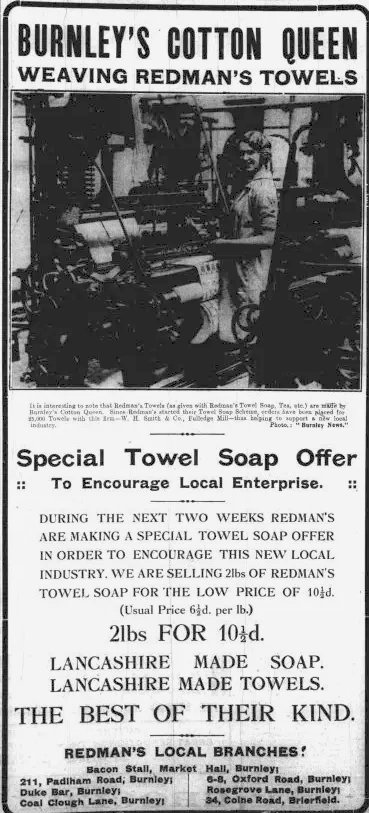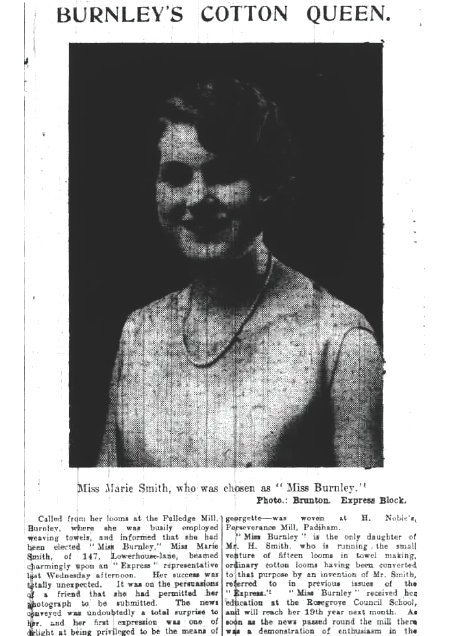 Lowerhouse Mile 'Cotton Queen' Memories - 1930
Lowerhouse Mile 'Cotton Queen' Memories - 1930 
(Page 1 of 5)
Miss Cotton Queen 1930
Between 1930 and 1939 a major annual event in the cotton towns of the North West was the annual Cotton Queen competition. This colourful ceremony was an antidote to the
depressed 1930s. It was a glamorous occasion and a romantic association with the daily routine of the cotton mills, which was even made into the story line of one
of the films of the day.
It was organised by the Daily Dispatch and sponsored by the cotton industry, as the aim was to promote cotton. Each year a Cotton Queen was elected and, and to be
eligible to enter a girl had to work in the cotton industry and be aged between 16 and 26. Would be Cotton Queens had to send their photo in to the newspaper. As
many as twenty towns, would then elect a local queen.
There was tremendous interest and crowds lined the streets for the big procession through local towns that ended with the crowning. All the local winners then went
to Blackpool for a few days and the national queen was chosen in a ceremony at the Tower Ballroom. It was a prestigious, exciting and glamorous role being the Cotton
Queen because for one year she did not have to work in the usual way but travelled the country, with a chauffeur and chaperone, promoting cotton goods.
The successful Cotton Queen wore a red velvet cloak trimmed with ermine, and a gold crown. She underwent three months training in deportment, elocution, and etiquette
to equip her for her duties. The winner was also able to choose a substantial wardrobe from all the best stores and fashion houses, such as Marshall and Snelgrove,
Debenham and Freebody, Liberty, Afflek and Brown, etc.
The Cotton Queen of 1931 chosen from 15 finalists from Burnley, Nelson and Colne was local girl Miss Marie Smith aged 18, who lived at 147 Lowerhouse Lane. She was a weaver of towels in a small enterprise run by her father in Fulledge Mill. Redmans the local grocers were quick to capitalise on the publicity and the Express printed photos of her weaving Redmans towels to use with their “towel soap”.



The ladies of Lowerhouse C.C., arranged a dance to celebrate at the mechanics, and became a big event involving a crowning ceremony, a cotton dress competition, and whist drive. The Burnley News reported that “Regally attired in a gown of white cotton (from the Co-op drapers), with a train of blue cotton velvet trimmed with white fur, entrancingly pretty, she afforded a vision of Lancashire Loveliness”, The Queen was preceded by a little page boy, Ronald Wilkinson, and followed by “thirteen beautifully attired girls” including some of her “Lowerhouse girl friends”, one being Grace Drabble. Mr. Hargreaves, chairman of Lowerhouse C.C. presented Miss Smith with a china tea service and expressed the club’s pride. He said the Ball was intended by the ladies to raise funds for a new tea room and additional seating at the club.
Miss Smith then made a speech saying this was the highlight of her year so far, and as a Lowerhouse girl she was happy to support her club. “The Cotton Trade has been waiting for an innings, given a chance it would not take long getting “set” and reaching world wide boundaries. Lancashire provided the best in cricket and cotton. “ The crowd sang “She’s a lassie from Lancashire”. The Empress Orchestra then played music for dancing, and the ball was deemed a “huge success.” which it may have been, but it didn’t make any money, and caused a huge fuss at the AGM in 1933.

